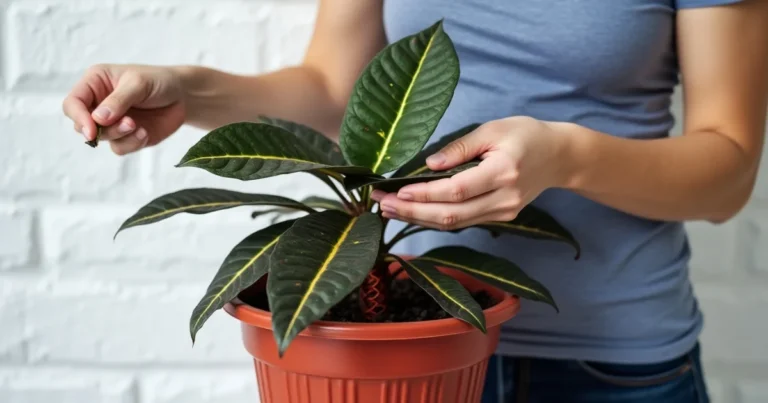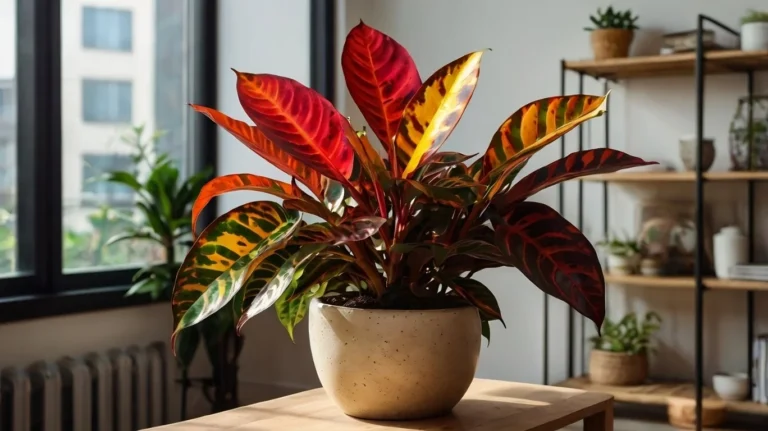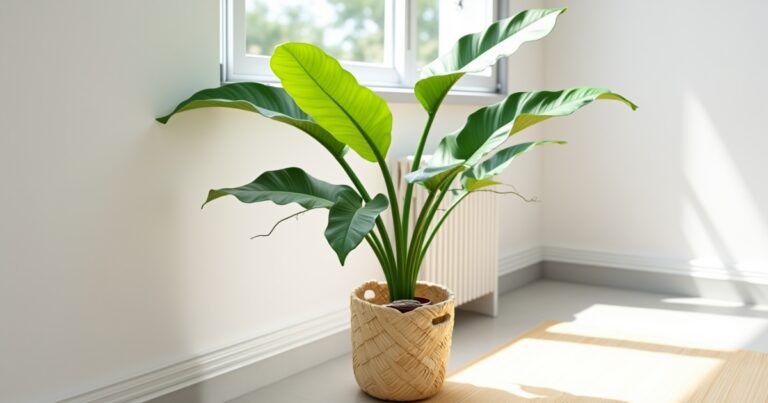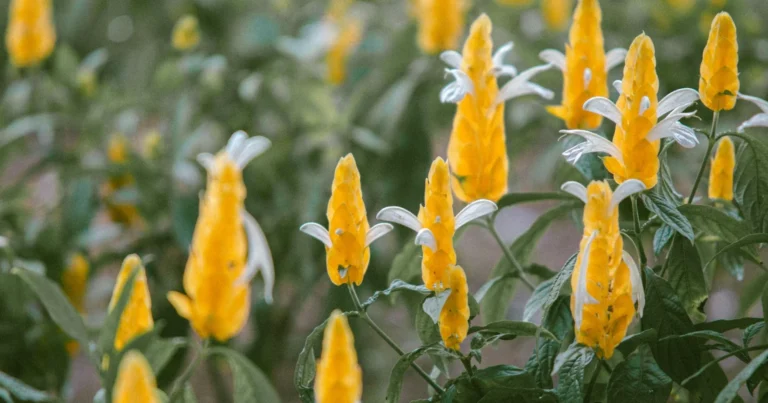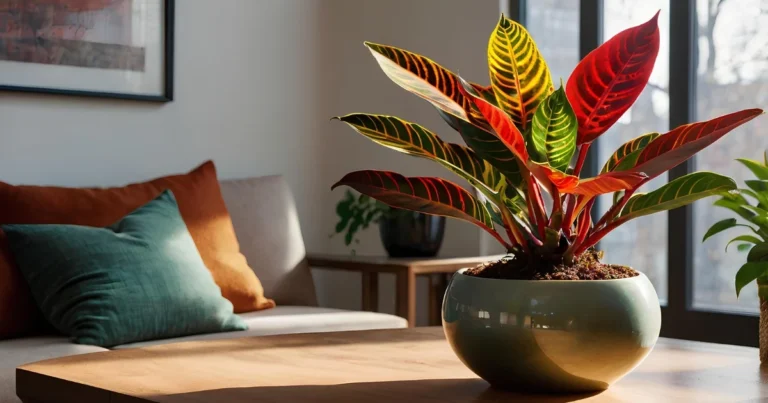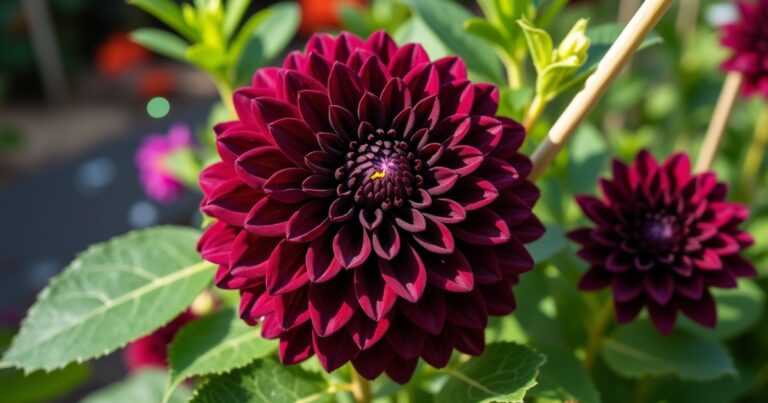Croton Petra Plant Care: Top 5 Secrets for Vibrant Growth In 2025

Showstopper in any house or garden is the Croton Petra Plant, with its brilliantly vivid leaves and luxuriant, tropical look. This vivid beauty deserves particular attention regardless of your level of experience as a plant parent or just beginning croton enthusiast. The catch is that maintaining your Croton Petra Plant in its best condition isn’t always simple. Those gorgeous, multicoloured leaves can fade rapidly without proper care, leaving you wondering why.
We’re delving deeply into the top 5 secrets to keeping a really vivid Croton Petra Plant in this post. You’ll learn everything you need to improve your Croton Plant Care from knowledge of the ideal conditions for growth to professional advice on water, light, and pruning. By the end, you will not only know how to make sure your Petra Croton Plant thrives for years to come but also how to maintain its present look. All set to discover the formula for a vibrant, healthy Croton Petra Plant? Let’s begin.
Table of Contents
Understanding Your Croton Petra Plant
The Croton Petra plant is one of the most stunning houseplants you can add to your collection, known for its vibrant, multicolored foliage that seems almost painted by nature itself. As someone who’s nurtured these beauties for years, I can tell you they’re worth every bit of attention they require.
What is a Croton Petra Plant?
The Croton Petra plant (Codiaeum variegatum ‘Petra’) belongs to the Euphorbiaceae family and is a tropical evergreen shrub prized for its spectacular leaves. Unlike many houseplants that rely on flowers for visual appeal, the Croton Petra’s claim to fame is its foliage—large, leathery leaves splashed with shades of green, yellow, orange, red, and even purple or black. Each leaf tells its own colorful story, with no two exactly alike.
Origins and natural habitat
Croton Petra plants originate from the warm, humid regions of Southeast Asia and the Pacific Islands, like Malaysia, Indonesia, and Australia. Naturally growing as understory plants, they receive filtered sunlight through the forest canopy. The name “Croton” comes from the Greek word “kroton“, meaning tick, due to the seed’s resemblance to the insect. These plants have been cultivated for centuries and were traditionally used as boundary markers by indigenous peoples.
The Unique Characteristics of Croton Petra
The croton plant petra comes from Indonesia. It loves warm, humid places. Its leaves are thick and glossy, showing off gold, red, orange, and green patterns. Here’s what to watch for:
- Leaf Texture: Leathery leaves signal its tropical origins, resisting pests but needing consistent moisture.
- Pattern Diversity: Each leaf’s design is unique, with colors intensifying in bright light.
- Size: Indoors, it can grow 3–6 feet tall with proper pruning and light.
Why Croton Petra Plants Change Colors
Color shifts aren’t random—they’re survival cues. Here’s what the hues reveal:
- Light Needs: Faded edges mean it’s seeking more light. The best locations are close to windows facing east or west.
- Seasonal Cycles: New growth often starts pale, darkening as leaves mature.
- Health Signals: Sudden green streaks might hint at nutrient deficiencies or stress.
Why leaves lose color or drop:
- Sudden environmental changes (Crotons hate being moved!)
- Insufficient light (causes fading of vibrant colors)
- Temperature fluctuations or cold drafts
- Transplant shock after repotting
- Natural leaf shedding (lower, older leaves)
Common Challenges for New Croton Owners
Even seasoned growers face hurdles with Crotons Plants. Here’s how to handle the most common problems:
- Leaf Drop: Normal after relocation, but excessive loss points to sudden temperature drops or drafts.
- Sensitivity to Change: Avoid moving it abruptly; gradual acclimation reduces shock.
- Watering Balance: Let soil dry slightly between waterings—overwatering is a top cause of root rot.

Factors that affect growth and vibrancy
| Factor | Impact on Croton Petra |
| Light intensity | Directly affects color development; more light = more vibrant colors |
| Water quality | Sensitive to chlorine and fluoride in tap water |
| Humidity levels | Low humidity causes brown leaf tips and dull appearance |
| Fertilization | Under-fertilization leads to pale foliage; over-fertilization to leaf burn |
| Pest infestations | Spider mites and mealybugs can quickly diminish plant health |
Understanding these challenges is the first step toward nurturing a thriving Croton Petra plant. With the right knowledge and care routine, you can transform a struggling specimen into the showstopping foliage plant it’s meant to be.
The Perfect Light and Temperature Balance
Mastering light and temperature is key to thriving petra croton plant care. These tropical beauties crave consistent conditions to keep their colorful leaves healthy and vibrant. Let’s break down what your plant needs to shine.
Finding the Ideal Light Exposure for Your Croton
Place your croton plant care near a window with bright, indirect light. East or north-facing windows work best—avoid harsh midday sun that can scorch leaves. Rotate your plant weekly to ensure even growth and color. Signs of too much light include faded colors; too little light causes leggy stems.
Seasonal Light Adjustments for Vibrant Foliage
Seasons change, so your plant’s needs do too. Use this guide to adjust placement:
| Season | Light Tips |
|---|---|
| Spring | Move to brighter spots as days lengthen |
| Summer | Shield from direct afternoon sun |
| Winter | Supplement with grow lights if natural light fades |
Temperature Requirements for Healthy Growth
Keep your plant in temperatures between 65–80°F (18–27°C). Avoid placing near vents, heaters, or drafty windows—sudden cold can cause leaf drop. Use a thermometer to monitor consistency. In winter, relocate the plant away from doorways to prevent shock.
Pairing these tips with the right light and warmth creates the perfect environment for your petra croton plant. Small adjustments mean big rewards for this colorful houseplant’s health.
Mastering the Watering and Humidity Needs
Caring for a croton like the Petra variety means paying close attention to moisture and humidity. It’s easy to overwater, which can cause root rot in wet soil. Always check the top two inches of soil with your finger before watering. Let it dry a bit between waterings, and use pots with holes to avoid water pooling.
- Water deeply when the top layer of soil feels dry.
- Reduce frequency in winter when growth slows.
- Watch for yellow leaves (overwatering) or crispy edges (underwatering).
Humidity is also key for croton Petra plant care. These tropical plants love 50-60% humidity. To boost moisture, you can:
- Pebble trays filled with water to raise local humidity.
- Portable humidifiers near your plant.
- Grouping plants to create a humid microclimate.
- Misting leaves gently with lukewarm water.
Adjust your methods based on your home’s conditions. A consistent routine keeps leaves lush. Avoid wet soil and let roots dry completely. Small changes ensure your Croton Petra thrives anywhere.

Soil Composition and Fertilization for Croton Petra Plants
Healthy soil and the right food are key for a croton petra plant to thrive. Without the proper mix and nutrients, even good light and water won’t help. Let’s explore how to feed your plant what it needs.
Creating the Optimal Soil Mix
Start with a mix that drains well but keeps some moisture. Mix:
- 2 parts premium potting soil
- 1 part perlite or coarse sand
- 1 part peat moss or coconut coir
Blend these to avoid waterlogging. Test drainage by watering—soil should never stay soggy for more than an hour.
Seasonal Fertilization Schedule
Feed your croton petra plant when it’s growing. Use a balanced liquid fertilizer (10-10-10 NPK) at half strength:
- Spring to Summer: Fertilize every 4-6 weeks when new leaves appear
- Fall to Winter: Cut back to once a month or stop entirely
Don’t over-fertilize, as it can burn leaves. Always water soil first to avoid root damage.
Signs of Nutrient Deficiency
Look for these signs your croton petra plant needs nutrients:
- Yellowing edges – Low potassium
- Pale new growth – Iron or magnesium shortage
- Brittle stems – Calcium deficiency
Adjust fertilizer ratios or use a micronutrient spray if issues persist. A soil pH test kit can also help spot imbalances.
Troubleshooting Typical Issues
Even with proper care, Croton Petra plants can experience problems that confuse their owners. Here’s a look at the most common issues and their solutions.
Why are the leaves of my Croton Petra plant disappearing?
Leaf drop is a frequent concern among Croton Petra owners. While it’s natural for older, lower leaves to shed occasionally, significant leaf loss often signals stress:
- Recent Relocation: Crotons dislike being moved. Allow 2-3 weeks for adjustment before making more changes.
- Watering Problems: Both underwatering and overwatering can cause leaf drop. Adjust based on soil moisture.
- Temperature Shock: Temperatures below 55°F (13°C) can cause severe leaf loss. Relocate to a warmer, stable spot.
- Seasonal Adjustment: Some leaf drop in fall and winter is normal as the plant enters a semi-dormant phase.
- Transplant Shock: After repotting, plants may lose leaves temporarily. Keep conditions stable and avoid fertilizing for a month.
Reviving a Dull or Wilting Croton Petra Plant
If your once-vibrant Croton looks dull or wilting, try these steps:
- Increase light gradually to avoid shock.
- Check watering habits; water based on soil dryness.
- Boost humidity if leaf tips are brown or crispy.
- Top-dress with fresh soil or repot if the plant has been in the same soil for years.
- Foliar feed with diluted fertilizer for a quick nutrient boost.
Quick Fixes for Spotted or Yellowing Leaves
Yellow or spotted leaves typically indicate specific problems that need quick action:
| Uniformly yellow leaves | Overwatering | Reduce watering and ensure proper drainage. |
| Yellow leaves with green veins | Iron deficiency or improper soil pH | Add chelated iron and check for slightly acidic soil. |
| Brown leaf edges | Low humidity | Increase ambient moisture and avoid heating vents. |
| Spotted leaves | Fungal issues (dark spots with yellow halos) | Remove affected leaves, increase airflow, consider fungicide. |
| Faded colors | Insufficient light | Gradually increase light exposure. |
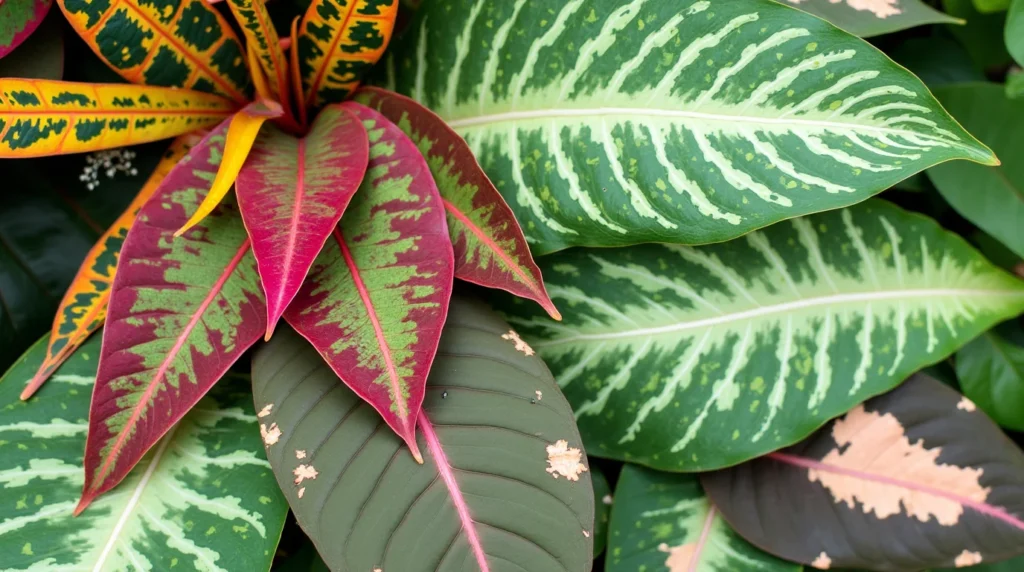
Conclusion: Enjoying Your Thriving Croton Petra Year-Round
Caring for a croton plant petra is rewarding. Its bold colors and lush foliage make it a great addition to any space. To keep it thriving, balance light, water, and nutrients.
Adjust your care as seasons change. Water less in winter and use a humidifier in dry air. Watch for signs of too much or too little water and fertilizer. Prune and propagate to keep your plant growing.
Even experienced plant owners face challenges like leaf drop or fading colors. These are part of learning your plant’s needs. With consistent care and patience, your petra croton plant will flourish.
It can be a kitchen accent or a statement piece. Its colors will change with the seasons if you meet its needs. Keep this guide handy to solve problems and celebrate new leaves. Your Croton Plant petra will grow with you, becoming a living art piece.
What are the ideal light conditions for my Croton Petra plant?
Your Croton Petra loves bright, indirect sunlight. Place it near a window for the best light. This keeps its colors vibrant and healthy.
How often should I water my Croton Petra?
Water your Croton Petra when the top inch of soil is dry. Avoid overwatering to prevent root rot. Keep the soil consistently moist but not soggy.
What type of soil is best for a Croton Petra plant?
Choose a well-draining, slightly acidic soil mix for your Croton Petra. A mix of potting soil, perlite, and peat moss or coco coir is perfect for its roots.
Why are the leaves on my Croton Petra turning yellow?
Yellow leaves can mean too much water, poor drainage, or not enough nutrients. Check the soil moisture and drainage. Also, think about fertilizing your plant.
How can I increase humidity for my Croton Petra?
Croton Petra likes a humidity of 50-60%. Use pebble trays, misting, or a humidifier to boost humidity. Grouping plants also helps create a humid environment.
How do I know if my Croton Petra is getting enough light?
If the leaves lose color or become leggy, it needs more light. The leaves should be rich in color and bushy.
How often should I fertilize my Croton Petra?
Fertilize your Croton Petra every 4-6 weeks in spring and summer. Use a balanced fertilizer. Cut back in fall and winter when it grows slower.
Is it normal for my Croton Petra to lose leaves after relocating it?
Yes, it's normal for Crotons to shed leaves when they move. They adjust slowly to new light, temperature, and humidity. Give them time to settle.

